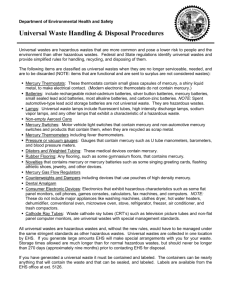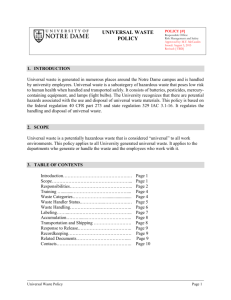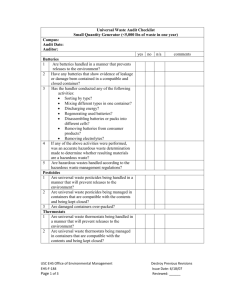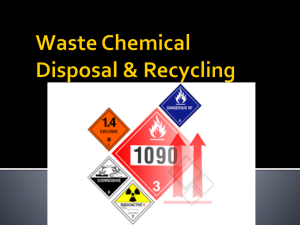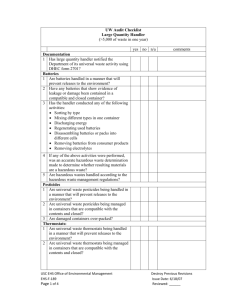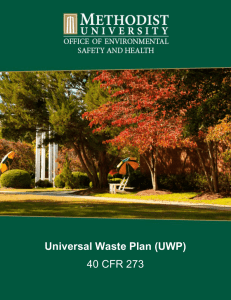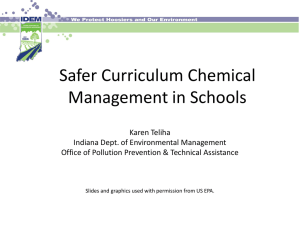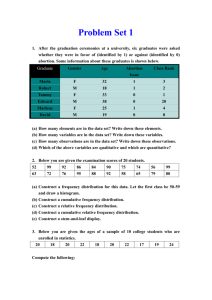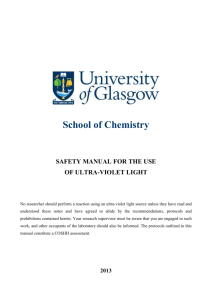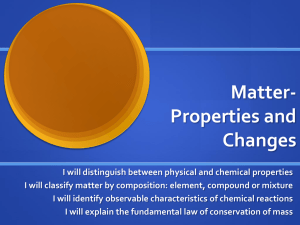Universal Waste Rule - Iowa Waste Reduction Center
advertisement
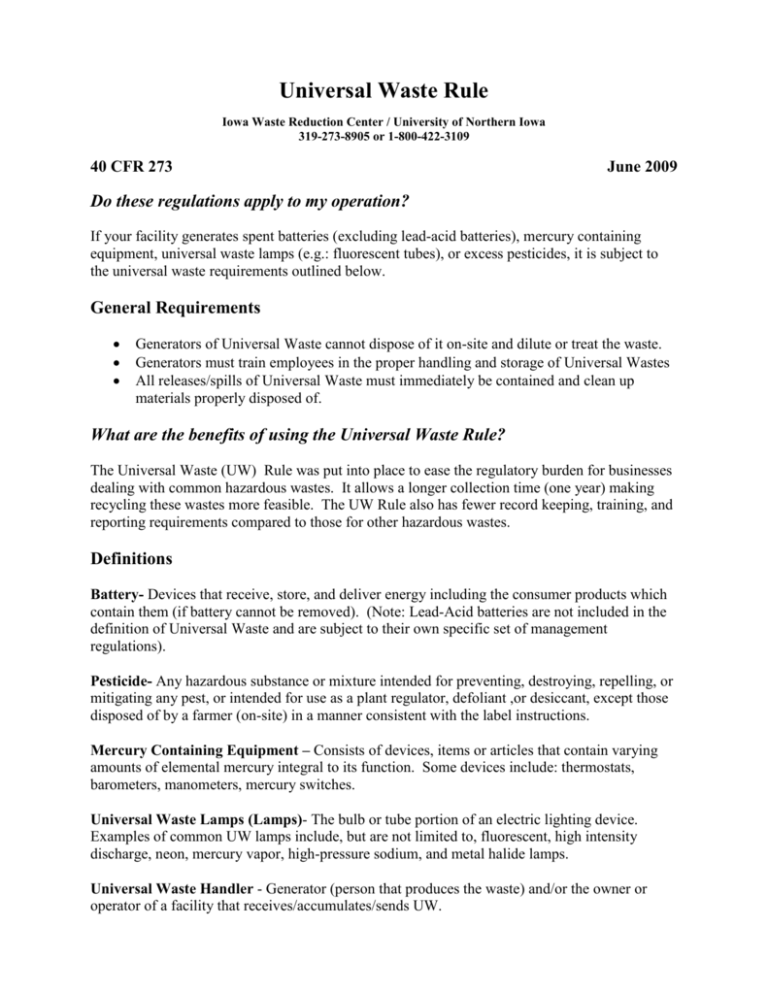
Universal Waste Rule Iowa Waste Reduction Center / University of Northern Iowa 319-273-8905 or 1-800-422-3109 40 CFR 273 June 2009 Do these regulations apply to my operation? If your facility generates spent batteries (excluding lead-acid batteries), mercury containing equipment, universal waste lamps (e.g.: fluorescent tubes), or excess pesticides, it is subject to the universal waste requirements outlined below. General Requirements Generators of Universal Waste cannot dispose of it on-site and dilute or treat the waste. Generators must train employees in the proper handling and storage of Universal Wastes All releases/spills of Universal Waste must immediately be contained and clean up materials properly disposed of. What are the benefits of using the Universal Waste Rule? The Universal Waste (UW) Rule was put into place to ease the regulatory burden for businesses dealing with common hazardous wastes. It allows a longer collection time (one year) making recycling these wastes more feasible. The UW Rule also has fewer record keeping, training, and reporting requirements compared to those for other hazardous wastes. Definitions Battery- Devices that receive, store, and deliver energy including the consumer products which contain them (if battery cannot be removed). (Note: Lead-Acid batteries are not included in the definition of Universal Waste and are subject to their own specific set of management regulations). Pesticide- Any hazardous substance or mixture intended for preventing, destroying, repelling, or mitigating any pest, or intended for use as a plant regulator, defoliant ,or desiccant, except those disposed of by a farmer (on-site) in a manner consistent with the label instructions. Mercury Containing Equipment – Consists of devices, items or articles that contain varying amounts of elemental mercury integral to its function. Some devices include: thermostats, barometers, manometers, mercury switches. Universal Waste Lamps (Lamps)- The bulb or tube portion of an electric lighting device. Examples of common UW lamps include, but are not limited to, fluorescent, high intensity discharge, neon, mercury vapor, high-pressure sodium, and metal halide lamps. Universal Waste Handler - Generator (person that produces the waste) and/or the owner or operator of a facility that receives/accumulates/sends UW. Small Quantity Handler of UW (SQHUW) - Never accumulates more than 11,000 pounds of UW (total of all types of UW) at any one time. Large Quantity Handler of UW (LQHUW) - Accumulates more than 11,000 pounds of UW (total of all types of UW) at any one time. Universal Waste Transporter - A person engaged in off-site transportation of universal waste by air, rail, highway, or water. Destination Facility- A facility that treats, disposes of, or recycles a UW. Destination facilities are required to comply with regulations beyond the scope of this summary. Requirements What are the special handling requirements for UW? All UW must be handled in a way that prevents release during accumulation, storage, and disposal. All spills and residues of UW must immediately be contained. All materials (including clean-up materials) resulting from spills of a UW must be handled in compliance with applicable federal, state, and local regulations. If a release of one pound or more of a UW occurs please contact the IWRC. Batteries o showing signs of leakage, damage, or spillage must be contained o may be sorted by type or mixed in one container o may be discharged or regenerated and packs may be disassembled o may be removed from consumer products o electrolytes may be removed provided batteries are immediately resealed Mercury Containing Equipment o Mercury containing equipment showing signs of leakage, damage, or spillage must be contained o Mercury ampules may be removed provided: It is done in a manner that prevents breakage over a collection device A mercury clean-up kit is readily available The removal area is well ventilated and monitored for OSHA compliance Spilled or leaked mercury is immediately transferred to a storage container Employees are thoroughly trained in proper handling and emergency procedures. Removed ampules are stored in closed, structurally sound, non-leaking containers in a manner that prevents breakage upon shipment Pesticides o Immediately clean up and place in a container any container that shows evidence of leakage, breakage, of damage. Universal Waste Lamps o Immediately clean up and place in a container any lamp that is broken, shows evidence of leakage, breakage, or damage. What are the Labeling, Record Keeping, and Storage Quantity Requirements? Handlers of UW cannot accumulate UW for more than one year unless it is done for the sole purpose of feasible recycling. Store UW in a container that remains closed, is structurally sound, compatible with the waste, prevents breakage, and lacks evidence of leakage or damage. Clearly identify the length of time the waste has been accumulated (i.e., labeling containers or waste, inventory system, etc.). Batteries - Label each battery or container “Universal Waste - Batteries,” “Waste Batteries,” “Used Batteries”. Pesticides - Label each storage container, vessel or tank with the label that accompanied the product and “Universal Waste - Pesticides” or “Waste Pesticides”. Mercury Containing Equipment - Label each piece of equipment or container: “Universal Waste - Mercury Containing Equipment”; “Waste Mercury-Containing Equipment”; or “Used Mercury-Containing Equipment”. Universal Waste Lamps - Label each lamp or container “Universal Waste - Lamps,” “Waste Lamps” or “Used Lamps”. What are the testing requirements? TCLP testing may be required to determine if clean-up materials and/or removed components/parts are considered hazardous wastes. What permits or registrations are required and how do I obtain them? SQHUW are not required to obtain a hazardous waste identification number from the EPA if only universal hazardous wastes are generated. LQHUW must obtain an EPA ID number prior to accumulating more than 11,000 pounds of UW. EPA notification to obtain the number (LQHUW only) must include at least: o Your facility’s name and address and the UW contact’s name and phone o Address of the physical location of the UW o Types of UW handled o A statement that more that 11,000 pounds of UW is accumulated at one time LQHUW that already have an EPA ID number do not need to notify the EPA of UW activities but must maintain their existing number. What training requirements apply? SQHUW must train all employees that handle UW in proper handling and emergency procedures. LQHUW must formally train (including documentation) all employees in proper handling and emergency procedure(s) for UW related to their responsibilities during normal facility operations and emergencies. How do I ship/transport universal waste(s)? Shipping UW waste must be sent to a UW handler, destination facility, or foreign market. Shipments must be packaged, labeled, marked, and placarded in a manner that prevents releases and follows all DOT requirements. The receiving party must agree to accept the waste. Handlers may self-transport universal waste, however, the handler must also comply with UW transporter regulations (summarized below). Exporting UW to a foreign market requires compliance with export regulations including notification of EPA and consent of the receiving country. UW handlers that also receive quantities of UW from other facilities should contact the IWRC. Transport Transporters cannot dispose of, dilute, or treat UW (except when responding to a release). Transporters of UW must comply with all DOT regulations. UW can only be stored at a transfer site for 10 days without further regulation. Transporters must immediately contain and clean up all releases/spills of UW and properly dispose of clean-up materials. Transporters must take UW to a destination facility, handler, or foreign market agreed upon by the generator/handler. What records do I need to keep and for how long? SQHUW are not required to keep records of shipments, however, as with all hazardous wastes, tracking quantities, dates of disposal, and destination facilities is advisable. LQHUW must track shipment of all UW o Must maintain a log, manifest, bill-of-lading, or other shipping documents that include at least the quantity of each type of UW, date of shipment of UW, and the name and address of destination facility for at least three years. SQHUW that accumulate more than 11,000 pounds of UW at one time, become a LQHUW and must then comply with LQHUW regulations for the remainder of the calendar year. The Iowa Waste Reduction Center can assist your small business in complying with the Universal Waste Rule. Please contact the IWRC at 800/422-3109 for free, confidential and non-regulatory environmental assistance.
